RESEARCH ON DATA MIGRATION OPTIMIZATION OF CEPH
MANQI HUANG, LAN LUO, YOU LI, LIANG LIANG
Chengdu University of Electronic Science and Technology University, Chengdu 611730, China
E-MAIL: qiluoli@126.com
Abstract:
Benefiting from its excellent performance and scalability,
Ceph distributed storage is also confronting the problems, i.e.
the unnecessary transfer of the data leading to the increasing
consumption of the system which is triggered by the additions
and deletions on the equipment. Aiming at the implement
method of Ceph in system algorithm and logical layout, this
paper has carried on research, analyzing its defects in the
aspect of data transfer and resource consumption and puts
forward the handling method of the failure node when the
cluster storage device fails. Through the establishment of the
cluster device flag in the process of data transfer, the
optimized scheme of the data migration in the environment of
production is realized, and the utilization of the system
resources is improved. The experimental test results have
shown that the scheme can reduce about the 30% -40% of
transfer volume, effectively lower the resources consumption
of Ceph distributed storage, as well as prevent invalid and
excessive data transfer.
Keywords:
Logical layout
Distributed storage; Data migration; Ceph storage;
1.
Introduction
The network era has developed tremendously with the
cloud computing, the global data volume has explosively
increased, and the demands of the big data storage have
undergone the tremendous changes. The size of the data
level has increased from Level PB to Level ZB and still
been growing. The development of big data has also
contributed to the rapid development of computing
network and storage technologies. Enterprises take the
depth analysis of data as the supporting point of profit
growth. The demands of analytical application of big data
are affecting the development of data storage infrastructure
[1]. In the terms of storage, Ceph is one of the admitted
excellent open source solutions now whose carrying-out
idea is SDS(Software-defined Storage). Ceph organizes the
resources of multiple machines and provides unified, large
capacity, high performance, and high reliable file services
for the outside to meet the needs of the large scale
978-1-5386-1010-7/17/$31.00 ©2017 IEEE 83
applications, so the architecture design can be easily
extended to PB level [2].
The optimization techniques for Ceph distributed
storage has also been concerned. The document [3]
proposes an adaptive disk speed reduction algorithm of
Ceph OSD (object stored device). The algorithm aims at
every single OSD, reducing the corresponding disk speed in
the low load and entering the energy saving condition. They
work only for saving energy on the part of OSD disks, so
the impact on the energy consumption of the whole system
is very limited. The document combines the characteristics
of the Crush algorithm and introduces the bucket of
configuration group PG (Power Group) in Crush Map to
redivide the set of fault domains. It is also called that data
replicas are first to be distributed among different power
groups before they are placed in different fault domains.
The nodes of the same power group are in the same energy
consumption condition, and the number of power groups is
equal to that of the copies [4]. However, these methods
cannot optimize the transfer number of PG during the
process of transfer.
This paper is optimized for the high performance data
migration in Ceph storage system which is the most popular
distributed open source cloud storage, and has a test
comparison between the optimized operation and the
original operation to verify the effectiveness of the
optimization. The optimization method proposed from this
paper can solve the excessive load of data migration caused
by Ceph storage, avoid the data loss caused by node failure
and improve the availability of Ceph object storage cluster.
2. Ceph systems and related algorithms
In a Ceph cluster, in order to store and manage the
data better, the data location is not obtained by look-up
table or index. Instead, it is calculated by the CRUSH, the
Controlled Replication under Scalable Hashing. Because
the simple HASH distribution algorithm cannot deal with
the change of the number of devices effectively, it will lead
to a great deal of data migration [5].
�
2.1. Introduction to CRUSH algorithm
Ceph developed the CRUSH algorithm to distribute
copies of objects efficiently in hierarchical storage clusters.
CRUSH implements a pseudo random (deterministic)
function whose parameters are object id or object group id,
and returns to a set of storage devices (used to save the
object copy OSD). The implementation of the CRUSH
algorithm requires Cluster Map (describes the hierarchical
structure of the storage cluster) and replica distribution
policy (rule) [6].
Thus, the CRUSH algorithm affects the distribution of
all the data in the cluster. In distributed storage system, how
to store data uniformly in each node, and keep low
consumption in data migration is an important index to
evaluate a distributed storage system.
2.2. Influence factors of CRUSH algorithm
There are two factors that affect the results of the
CRUSH algorithm. One is the structure of Cluster Map, and
the other is CRUSH Rule.
Cluster Map manages all the OSD in the current Ceph,
and Cluster Map specifies a range of the CRUSH algorithm
in which OSD is selected. Cluster Map is a tree structure
whose leaf nodes represent device (it is also called OSD)
and other nodes are called bucket nodes which are
imaginary nodes and can be abstracted according to their
physical structure. The tree structure has only one final root
node called the root node, and the virtual bucket node in the
middle can be the data center abstraction, machine room
abstraction, frame abstraction, and host abstraction. Each
node has a weight value that equals to the sum of the
weights of all the child nodes. The weight of the leaf node
is determined by the capacity of the OSD, and generally
setting the weight of the 1T is 1. This weight value also
plays an important role in the CRUSH algorithm. The data
layout of OSD selected through CRUSH is shown in Fig.1
[7].
Fig.1 Cluster Map Structure drawing
The paper special specified that there are four types of
Bucket's Type. They are Uniform, List, Tree and Straw
respectively. The four Buckets fit to different scenarios,
which affect the CRUSH algorithm. The more commonly
used is Straw, and the reason is that Straw is a lottery type
Bucket which chose the child node to consider the weight
of it, which is the fairest Bucket type. As shown in Fig.2.
Fig.2 Formation process of Straw Bucket
Straw Bucket first generates the straw based on the
weight of each node, and finally makes up the straw [] array.
In the process of locating the replicas of straw, each
location needs to loop through all the items, length draw =
CRUSH (x, R, item_id) *straw[i]. Find out the longest draw
as the last to choose this location to the copy [8].
The second is Introduction to CRUSH Rule. There are
3 main points of CRUSH Rule: a.Start by selecting a node
from the OSDMap. b.Use the selected node as the fault
isolation domain, so as not to be checked later. c. Locate
replica search patterns (breadth first, or depth first).
3. Logical layout and optimization
3.1. Ceph node selection process
A PG (Placement Group) is a logical collection of
several objects. In order to ensure the reliability of the data,
these objects are copied to multiple OSD, and according to
the copy level of the Ceph storage pool each PG will be
copied and distributed to more than one OSD on Ceph
cluster. PG can be regarded as a logical container
containing multiple objects that are mapped to multiple
OSD[9]. As shown in Fig.3.
The process of Ceph distributing data: firstly, calculate
the Hash value of the data X and mod the number of the
result and PG to get the number of data X corresponding to
PG. Then, the PG is mapped to a set of OSD through the
CRUSH algorithm. Finally, the data X is stored in the OSD
corresponded to PG. This process contains two mappings,
and the first is the mapping from data X to data PG. PG is
an abstract storage node which will not increase or decrease
with the physical node joining or leaving, so the data
mapping to PG is stable.
84
�
selects an OSD under host. As shown in Fig.4.
This is a PG (x0) mapping selection process.
1.
rep=0r=0,c(root,x0,0)=host0
c(host0.x0,0)=OSD.0,ok
rep=1r=1,c(root,x0,1)=host2
c(host2.x0,1)=OSD.8,ok
rep=2r=2,c(root,x0,2)=host1
c(host1.x0,2)=OSD.3,ok
2.
3.
Eventually, the PG is mapped to [0,8,3].
Fig.3 The logical diagram of PG
In the process of (osd0, osd1, osd2 … osdn) =
CRUSH(x), PG played two roles: the first is to partition the
data partitions. Each data range managed by PG is same, so
the data can be evenly distributed over the PG. The second
function is to play the role of Token, which determines the
location of the partition [10].
In the process of selecting OSD from the client PG,
first of all, you need to know which node in Cluster Map
starts to find from rules, and the entry point defaults to
default that is the root node. Then the isolated domain is
host node (that is to say, the same host cannot select two
child nodes) [11]. In the selection process from default to
host, the default selects the next child node based on the
bucket type of the node. According to the types of them, the
child node never stops until it chooses the host, and then
3.2. Problems arise
Throughout the operation, the OSD daemon of Ceph
checks the heartbeat of each OSD, and report to Ceph's
Monitor. If a node's OSD is broken, Monitor will set the
state of the OSD to Down.
When the OSD.0 data is corrupted, we would only
have expected to migrate OSD.0. However, due to the
backup redundancy of Ceph 3 copies’ form, when the
OSD.0 state is Down, needing to select an additional OSD
on the host0. Then select one copy from (OSD.3, OSD.8).
However, because the other PG OSD.3 and OSD.8 data
may migrate with additional 30% to 70% migration
increased. In extreme cases, when the OSD.0 is DOWN and
OSD.8 serves as Primary, two another new OSD are added
will cause a large amount of data load. If the appropriate
OSD is not selected, it will drop this node and select again,
while Choose does not consider the following steps when
selecting Bucket, determining directly after the selection.
This requires us to do some optimizations on the problem
of node replacement.
Previously, the problem of replacing the faulty nodes
in the Ceph cluster as follows.
Fig.4 Ceph structure diagram
85
�
/etc/init.d/Ceph stop
4. Application and test
a) Stop
the OSD process:
OSD.0
b) Mark node status as Out: Ceph OSD out OSD.0
Tell Monitor that the node is already out of service, and
that data needs to be restored on other OSD.
c) Remove nodes in CRUSH: Ceph OSD CRUSH
remove OSD.0
Let the clustering CRUSH be recalculated at a time,
otherwise the CRUSH Weight of the node will affect the
current host's Host CRUSH Weight.
d) Delete node: Ceph OSD rm OSD.0.
The operation removes the record of this node from
the cluster.
e) Delete node authentication, and numbers will be
occupied without deleting: Ceph auth del OSD.0
This operation removes information about this node
from authentication
The above operation will trigger the two migrations,
one after the node OSD and the other after the CRUSH
Remove, and the two migrations are very bad for the
cluster.
3.3. Configuration optimization
a) Make multiple tags for the cluster to prevent
migration.
Norebalance, this mark bit will make the CEPH cluster
not doing any cluster rebalancing.
Nobackfill, this mark bit will make the CEPH cluster
not doing any data backfill.
Norecover, this mark bit will make the CEPH cluster
not doing any cluster rebalance [9].
Remarks: there will be some places behind talking
about to remove these settings
b) CRUSH Reweight specifies the OSD value is 0.
Stop the OSD process to tell the cluster that this OSD
is no longer mapping data and no more serving. Because
there is no weight, it will not affect the overall distribution,
and there will be no migration.
c) CRUSH Remove specifies the OSD.
Delete the specified OSD. Deleting from CRUSH, and
it is already 0, so there is no impact on the host's weight,
thus there is no migration.
Delete node: Ceph OSD rm OSD.0
Delete the record of this node from the cluster.
d) Add new OSD.
e) Remove flag.
Because the middle state is only marked and no data
migration occurs, the migration of data occurs only after the
tag is lifted [14].
The basic environment consists of 3 nodes. Each node
has 3 OSD (50G). The number of copies is set to 3, and the
number of PG is set to 664.
4.1. Application test
4.1.1.
Original method
set noout
Ceph osd set noout
# Ceph pg dump pgs|awk '{print $1,$15}'|grep -v pg >
pg1.txt
stop osd process
# /etc/init.d/Ceph stop osd.4
out osd
# Ceph osd out 4
wait rebalance
# Ceph pg dump pgs|awk '{print $1,$15}'|grep -v pg >
pg2.txt
# diff -y -W 100 pg1.txt pg2.txt
--suppress-common-lines
# diff -y -W 100 pg1.txt pg2.txt
--suppress-common-lines|wc -l
531
remove crush and osd
# Ceph osd crush remove osd.4
Ceph auth del osd.1
Ceph osd rm 1
wait rebalance
# Ceph pg dump pgs|awk '{print $1,$15}'|grep -v
pg > pg3.txt
# diff -y -W 100 pg2.txt pg3.txt
--suppress-common-lines|wc -l
90
add osd
# Ceph-deploy osd prepare --zap-disk Ceph1:/dev/vdd
# Ceph-deploy osd activate-all
wait rebalance
# Ceph pg dump pgs|awk '{print $1,$15}'|grep -v pg >
pg4.txt
86
�
number
From Table 1 and Fig.5 you can see the amount of
migration before and after optimization, and if you use the
optimization scheme, you can save about 37% of the
migration.
Fig.5 test 1 data comparison: Host 3\ OSD 3\Replication 3
PG 664
The basic environment used in testing 2 is composed
of 2 nodes, each node has 4 OSD about 50G, the number of
copies is set to 2, the number of PG is set to 664, and the
test results are shown in Table 2 and Fig.6.
operation
done
Table 2 Test 2 data comparison
Primary
migration mode
stop osd (0)
out osd(231)
crush remove
osd (90)
add osd(99)
420
Optimized migration
mode
set mark(0)
crush reweight osd(0)
crush remove osd (0)
add osd(263)
263
PG migration
number
4.1.2.
Improved configuration
set norebalance, nobackfill, norecover
# Ceph osd set nobackfill
# Ceph osd set norecover
# Ceph pg dump pgs|awk '{print $1,$15}'|grep -v
pg > pg1.txt stop osd process # /etc/init.d/Ceph stop osd.4
crush reweight # Ceph osd crush reweight osd.4 0
# Ceph pg dump pgs|awk '{print $1,$15}'|grep -v
pg > 3pg2.txt # diff -y -W 100 3pg1.txt 3pg2.txt
--suppress-common-lines|wc -l
98 remove osd Ceph osd rm osd.4
add osd # Ceph-deploy osd prepare --zap-disk
Ceph1:/dev/vdd # Ceph-deploy osd activate-all
unset norebalance, nobackfill, norecover
# Ceph osd unset nobackfill
# Ceph osd unset norecover
wait rebalance # Ceph pg dump pgs|awk '{print $1,$15}'|grep -v
pg > 3pg3.txt
# diff -y -W 100 3pg1.txt 3pg3.txt
--suppress-common-lines|wc -l
563
4.2. Test result
The migration results of
the
compared by Table 1 and Fig. 5 below.
two methods are
Table 1 Test 1 data comparison
operation done
PG migration
Primary
migration
mode
stop osd (0)
out osd(121)
crush remove
osd (146)
add osd(201)
468
Optimized migration
mode
set mark(0)
crush reweight osd(0)
crush remove osd (0)
add osd(224)
263
87
Fig.6 test 1 data comparison: Host2\ OSD 4 \Replication 2\
PG 664
�
Saving Technologies Based on Ceph[J]”, Computer
Engineering, August 2015.
[5] Sage A Weil, Scott A Brandt and Ethan L Miller et al.
Author, “CRUSH: Controlled,scalable,decentralized
placement of replicated data [C]”, In Proceedingsof
the
on
Supercom-uting(SC’06), Tampa, November 2006.
Conference
/IEEE
ACM
2006
[6] Way
[7] Mu Yanliang
“Way
Forever.Ceph. Author,
Forever.
Introduction of CRUSH data distribution algorithm
based on Ceph. [EB/OL]”, October 2015.
and Xu Zhenming. Author,
“AnImproved CRUSH Algorithm
on
Temperature factor in Ceph Storage[J]”, Journal of
Chengdu University of Information Technology, June
2015.
based
[8] Cheng X P. Author, “Ceph source code analysis:
CRUSH algorithm[EB/OL]”, May 2016.
[9] Karan Singh. Author,
“Ceph Cookbook[M]”,
Birmingham:Packt Publish Ltd, 169-170, 2016.
[10] WuXiangwei. Author, “Ceph analysis:
distribution of
the CRUSH algorithm and
consistency of Hash. [EB/OL]”, September 2014.
the data
the
[11] w2bc. Author, “Ceph data storage of the road (3) ---
PG select OSD process (crush algorithm). [EB/OL]”,
November 2015.
[12] H3C. Author, “Cloud storage Summit. [EB/OL]”, June
2016.
[13] KangJianhua. Author, “Ceph cluster OSD fault repair
example demonstration”, December 2015.
[14] MOZ. Author, “The optimization and analysis of the
replacement of OSD operation. [EB/OL]”, September
2016.
From Table 2 and Fig.6, you can see the amount of
migration before and after optimization. If you use the
optimization scheme, you can save about 43% of the
migration.
5. Conclusions
This paper first analyzes the process of CRUSH
algorithm choosing Ceph. In
the actual production
environment, it is found that if the OSD fault occurs, using
the traditional data migration method will increase the
amount of data migration. When deleting a fault OSD in the
actual operating environment, setting flag values to close
the migration can prevent invalid and excessive migration.
The test proves that the method is feasible and effective.
However, in the actual production environment, there is
always need to pay attention to other problems, For
example, the actual production loop has the function of
automatic Out. Users can consider themselves to control,
and it need to deploy early and establish reliable real-time
monitoring system to prevent the system in the automatic
completion of data balance to trigger the performance
degraded.
Acknowledgements
This paper was supported by the National Natural
Science Foundation of China (Grant No. 61370073), the
National High Technology Research and Development
Program of China (Grant No. 2007AA01Z423), the project
of Science and Technology Department of Sichuan
Province, and Chengdu Civil-military Integration Project
Management Co., Ltd.
References
[1] hc360. Author, “Thoughts and suggestions on big
[EB/OL]”,
in cloud environment
storage
data
November 2015.
[2] Feng Youle, and Zhu Liuzhang. Author, “Analysis and
Improvement
of CEPH Dynamic Metadata
Management[J] ”, Electronic Technology, September
2010.
[3] Bisson T, Wu J and Brandt S A. Author, “A
Distributed Spin -downAlgorithm for an Object-based
Storage Device with Write R edirection C /
/Proceedings of the 7th Work-shop on Distributed
Data and Structures”, USA, 459-468, 2006.
[4] Shen Lianghao, WU Qingbo, and Yang Shazhou.
Author, “Research on Distributed Storage Energy
88
�
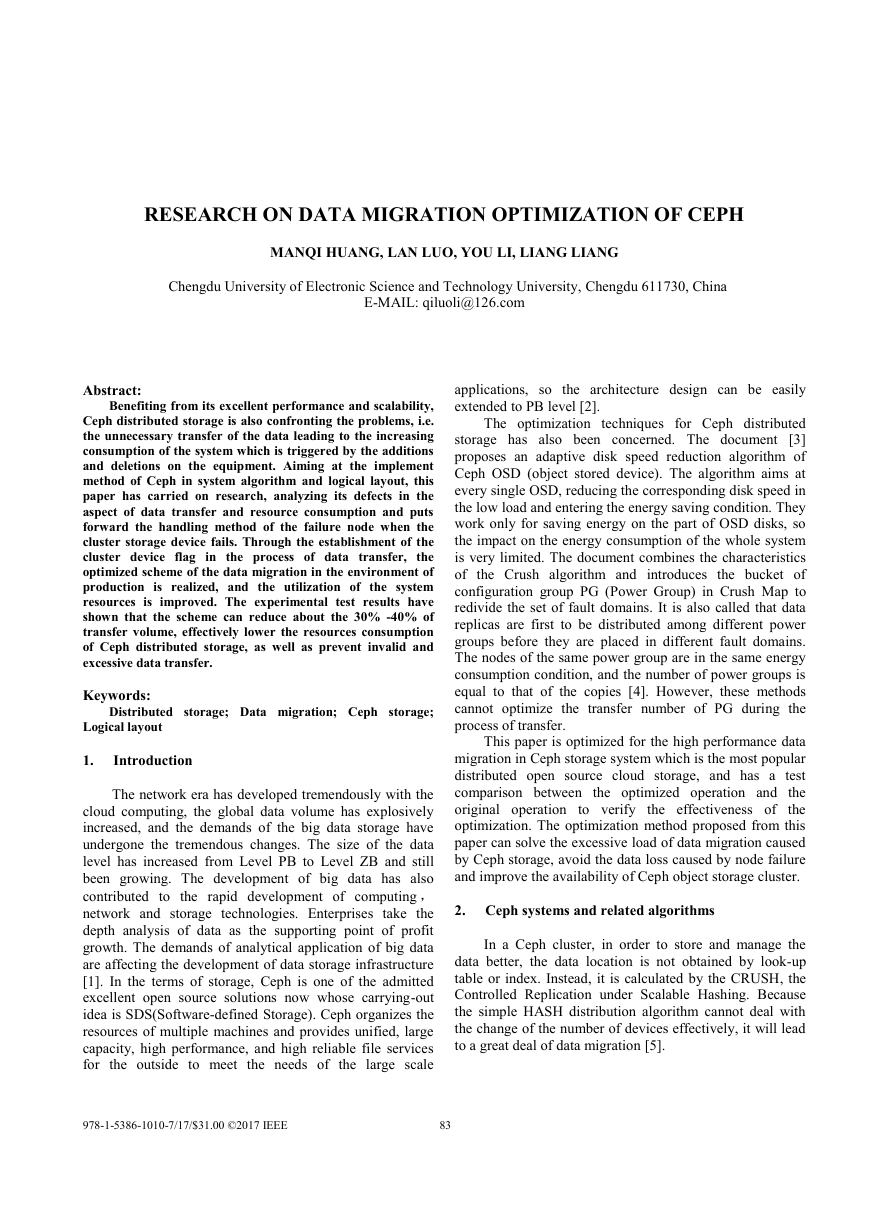
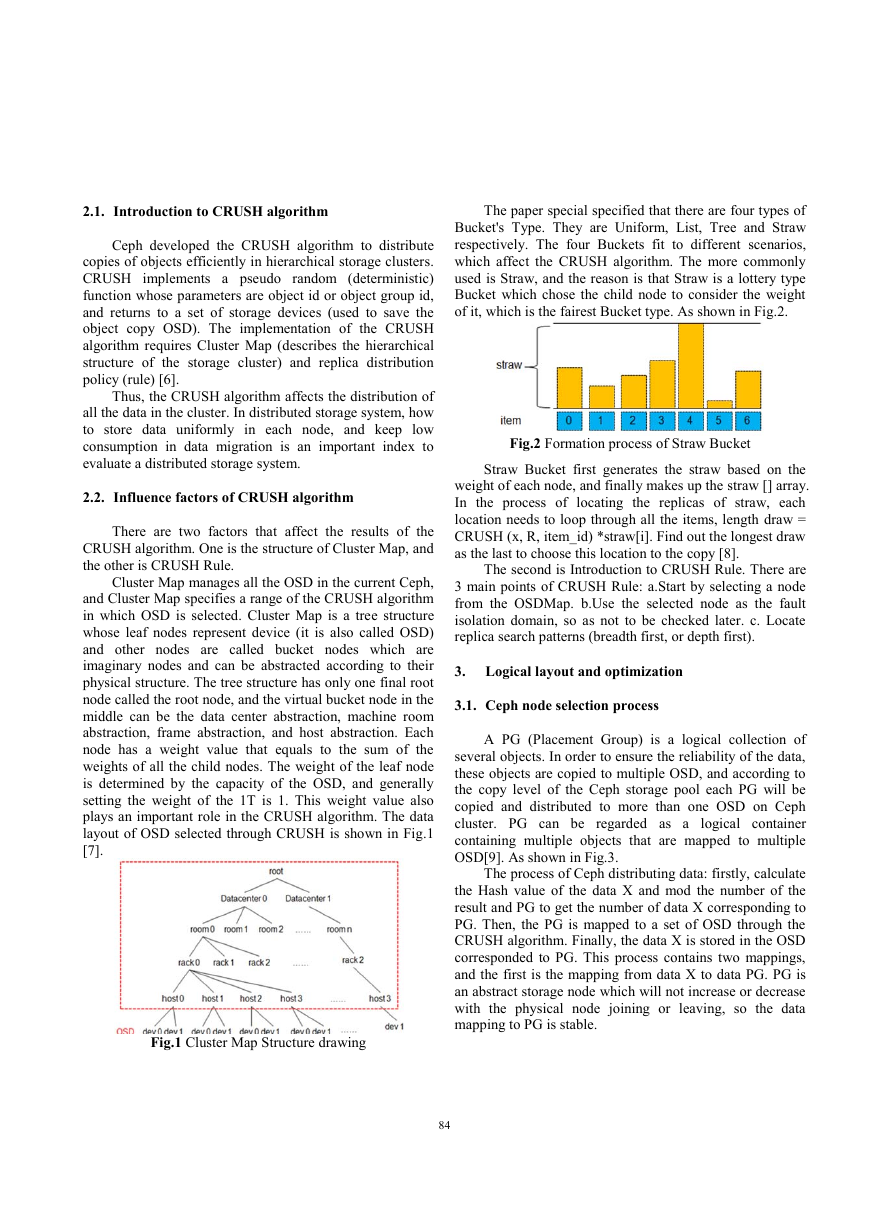

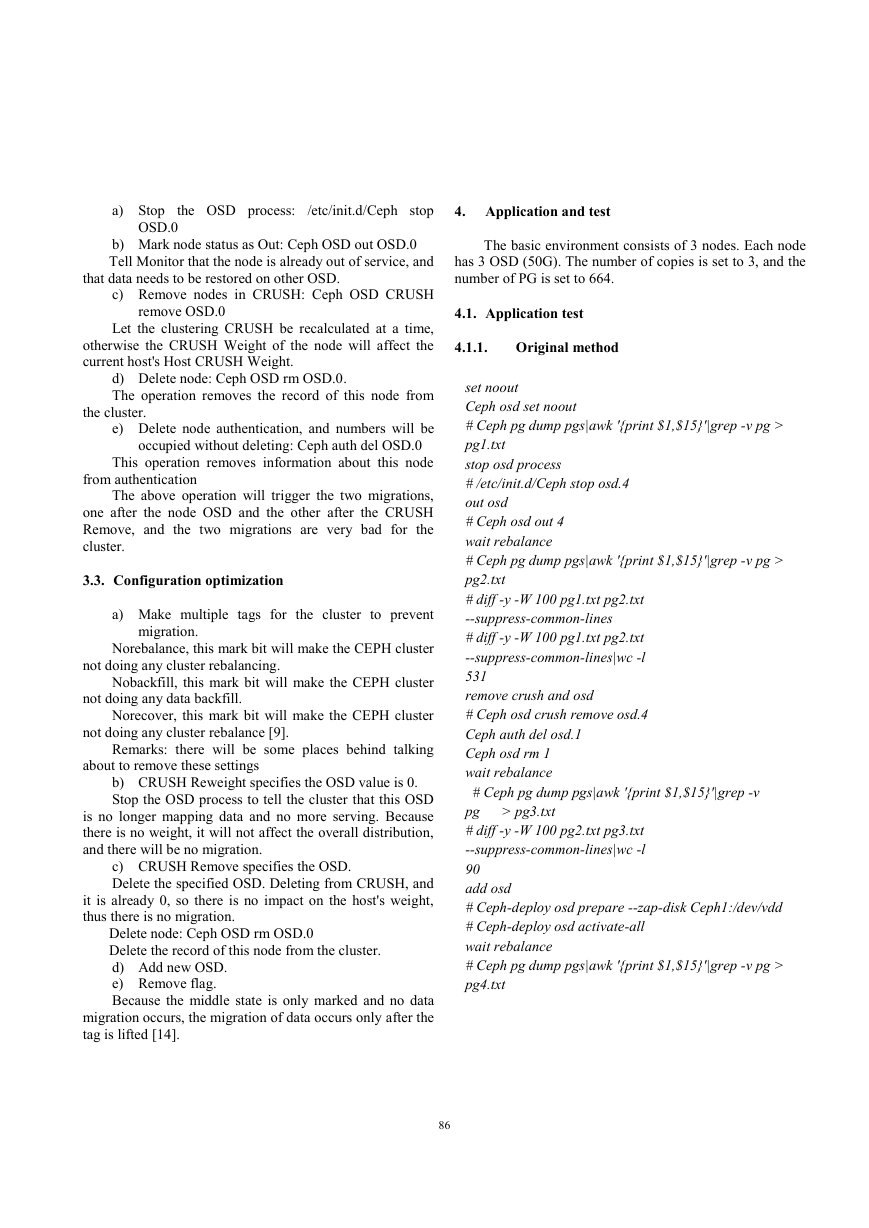
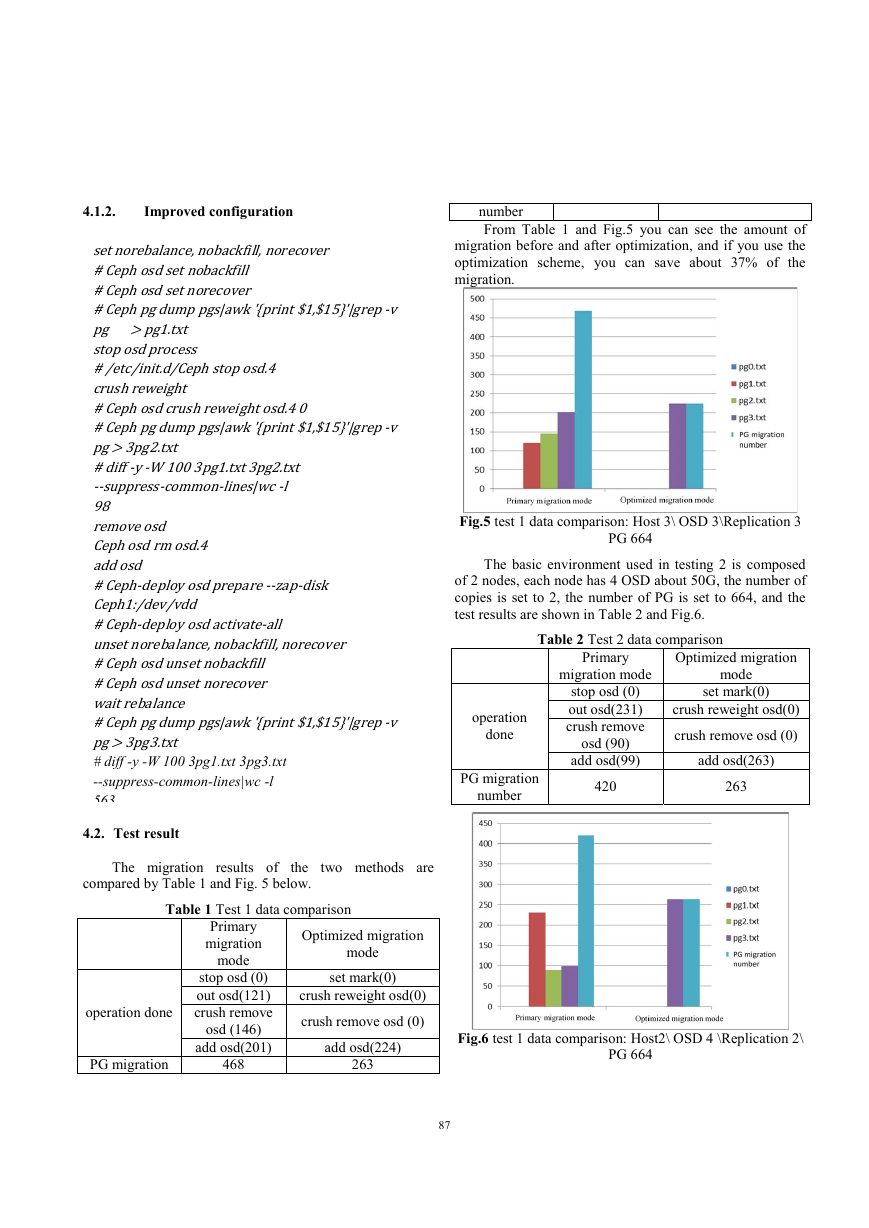
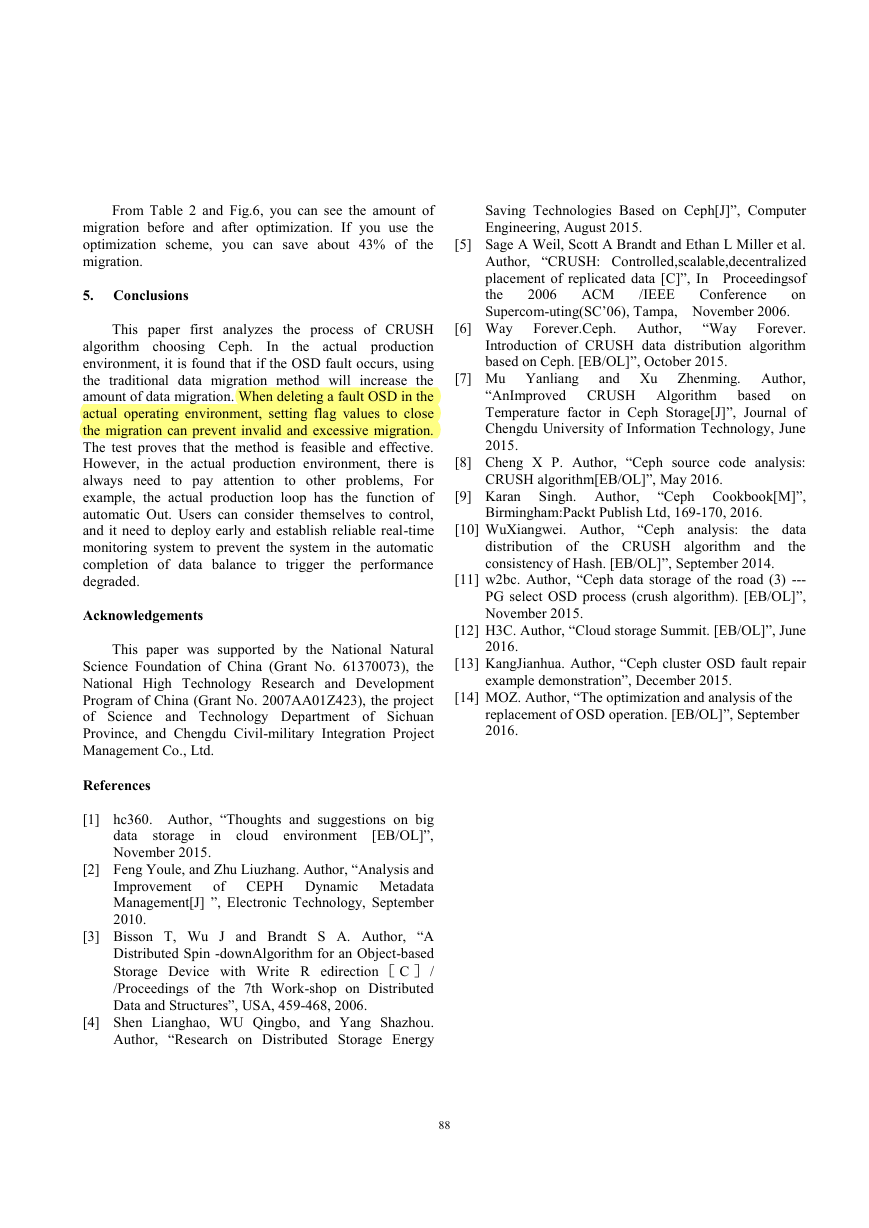






 2023年江西萍乡中考道德与法治真题及答案.doc
2023年江西萍乡中考道德与法治真题及答案.doc 2012年重庆南川中考生物真题及答案.doc
2012年重庆南川中考生物真题及答案.doc 2013年江西师范大学地理学综合及文艺理论基础考研真题.doc
2013年江西师范大学地理学综合及文艺理论基础考研真题.doc 2020年四川甘孜小升初语文真题及答案I卷.doc
2020年四川甘孜小升初语文真题及答案I卷.doc 2020年注册岩土工程师专业基础考试真题及答案.doc
2020年注册岩土工程师专业基础考试真题及答案.doc 2023-2024学年福建省厦门市九年级上学期数学月考试题及答案.doc
2023-2024学年福建省厦门市九年级上学期数学月考试题及答案.doc 2021-2022学年辽宁省沈阳市大东区九年级上学期语文期末试题及答案.doc
2021-2022学年辽宁省沈阳市大东区九年级上学期语文期末试题及答案.doc 2022-2023学年北京东城区初三第一学期物理期末试卷及答案.doc
2022-2023学年北京东城区初三第一学期物理期末试卷及答案.doc 2018上半年江西教师资格初中地理学科知识与教学能力真题及答案.doc
2018上半年江西教师资格初中地理学科知识与教学能力真题及答案.doc 2012年河北国家公务员申论考试真题及答案-省级.doc
2012年河北国家公务员申论考试真题及答案-省级.doc 2020-2021学年江苏省扬州市江都区邵樊片九年级上学期数学第一次质量检测试题及答案.doc
2020-2021学年江苏省扬州市江都区邵樊片九年级上学期数学第一次质量检测试题及答案.doc 2022下半年黑龙江教师资格证中学综合素质真题及答案.doc
2022下半年黑龙江教师资格证中学综合素质真题及答案.doc